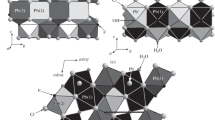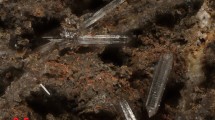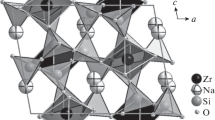Abstract
Sr- and Ca-rich waylandite, \( {\left( {{\hbox{B}}{{\hbox{i}}_{0.{54}}}{\hbox{S}}{{\hbox{r}}_{0.{31}}}{\hbox{C}}{{\hbox{a}}_{0.{25}}}{{\hbox{K}}_{0.0{1}}}{\hbox{B}}{{\hbox{a}}_{0.0{1}}}} \right)_{\Sigma 1.12}}{{\hbox{H}}_{0.{18}}}{\left( {{\hbox{A}}{{\hbox{l}}_{{2}.{96}}}{\hbox{C}}{{\hbox{u}}_{0.0{2}}}} \right)_{\Sigma 2.98}}{\left[ {{{\left( {{{\hbox{P}}_{0.{97}}}{{\hbox{S}}_{0.0{3}}}{\hbox{S}}{{\hbox{i}}_{0.0{1}}}} \right)}_{\Sigma 1.00}}{{\hbox{O}}_4}} \right]_2}{\left( {\hbox{OH}} \right)_6} \), from Wheal Remfry, Cornwall, United Kingdom has been investigated by single-crystal X-ray diffraction and electron microprobe analyses. Waylandite crystallises in space group R \( \overline 3 \) m, with the cell parameters: a = 7.0059(7) Å, c = 16.3431(12) Å and V = 694.69(11) Å3. The crystal structure has been refined to R 1 = 3.76%. Waylandite has an alunite-type structure comprised of a rhombohedral stacking of (001) composite layers of corner-shared AlO6 octahedra and PO4 tetrahedra, with (Bi,Sr,Ca) atoms occupying icosahedrally coordinated sites between the layers.



Similar content being viewed by others
References
Basciano LC, Peterson RC (2007) The crystal structure of ammoniojarosite, (NH4)Fe3(SO4)2(OH)6 and the crystal chemistry of the ammoniojarosite-hydronium jarosite solid-solution series. Mineral Mag 71:427–441
Basciano LC, Peterson RC (2008) Crystal chemistry of the natrojarosite-jarosite and natrojarosite-hydronium jarosite solid-solution series: a synthetic study with full Fe site occupancy. Am Mineral 93:853–862
Bayliss P, Kolitsch U, Nickel E, Pring A (2010) Alunite supergroup: recommended nomenclature approved by CNMNC. Mineral Mag 74
Blount AM (1974) The crystal structure of crandallite. Am Mineral 59:41–47
Brese N, O’Keeffe M (1991) Bond valence parameters for solids. Acta Crystallogr B47:192–197
Bruker (2003) SAINT, SADABS and SHELXTL. Bruker AXS Inc, Madison
Clark AM, Couper AG, Embrey PG, Fejer EE (1986) Waylandite: new data, from an occurrence in Cornwall, with a note on ‘agnesite’. Mineral Mag 50:731–733
Ferraris G, Ivaldi G (1984) X-OH and O-H...O bond lengths in protonated oxoanions. Acta Crystallogr B40:1–6
Grey IE, Birch WD, Bougerol C, Mills SJ (2006) Unit-cell intergrowth of pyrochlore and hexagonal tungsten bronze structures in secondary tungsten minerals. J Solid State Chem 179:3860–3869
Grey IE, Mumme WG, Bordet P, Mills SJ (2008) A new crystal-chemical variation of the alunite-type structure in monoclinic PbZn0.5Fe3(AsO4)2(OH)6. Can Mineral 46:1355–1364
Grey IE, Mumme WG, Mills SJ, Birch WD, Wilson NC (2009) The crystal chemical role of zinc in alunite-type minerals: structure refinements for pure and zincian kintoreite. Am Mineral 94:676–683
Jambor JL (1999) Nomenclature of the alunite supergroup. Can Mineral 37:1323–1341
Kato T (1990) The crystal structure of florencite. Neues Jb Miner Monatsh 227–231
Kharisun TMR, Bevan DJM, Pring A (1997) The crystal structure of kintoreite, PbFe3(PO4)2(OH, H2O)6. Mineral Mag 61:123–129
Kolitsch U, Tiekink ERT, Slade PG, Taylor MR, Pring A (1999) Hinsdalite and plumbogummite, their atomic arrangements and disordered lead sites. Eur J Mineral 11:513–520
Libowitzky E, Beran A (2004) IR spectroscopic characterisation of hydrous species in minerals. In: Beran A, Libowitzky E (eds) Spectroscopic methods in mineralogy, vol 6. EMU Notes in Mineralogy, Eötvös University Press, Budapest, pp 227–279.
Madsen IC, Grey IE, Mills SJ (2010) In situ diffraction studies: thermal decomposition of a natural plumbojarosite and the development of Rietveld-based data analysis techniques. Mater Sci Forum 651:37–64
Mills SJ (2007) The crystal chemistry and geochronology of minerals from Broken Hill. PhD Thesis, University of Melbourne, 249 pp
Mills SJ, Grey IE, Mumme WG, Miyawaki R, Matsubara S, Bordet P, Birch WD, Raudsepp M (2008) Kolitschite, Pb[Zn0.5,□0.5]Fe3(AsO4)2(OH)6, a new mineral from the Kintore opencut, Broken Hill, New South Wales. Aust J Mineral 14:15–19
Mills SJ, Hatert F, Nickel EH, Ferraris G (2009a) The standardisation of mineral group hierarchies: application to recent nomenclature proposals. Eur J Mineral 21:1073–1080
Mills SJ, Kampf AR, Raudsepp M, Christy AG (2009b) The crystal structure of Ga-rich plumbogummite from Tsumeb, Namibia. Mineral Mag 73:837–845
Mills SJ, Madsen IC, Grey IE, Birch WD (2009c) In situ XRD study of the thermal decomposition of natural arsenian plumbojarosite. Can Mineral 47:683–696
Mills SJ, Kartashov PM, Kampf AR, Raudsepp M (2010) Arsenoflorencite-(La), a new mineral from the Komi Republic, Russian Federation: description and crystal structure. Eur J Mineral 22:613–621
Sato E, Nakai I, Miyawaki R, Matsubara S (2009) Crystal structures of alunite family minerals: beaverite, corkite, alunite, natroalunite, jarosite, svanbergite, and woodhouseite. Neues Jb Miner Abh 185:313–322
Scharm B, Scharmová M, Kundrát M (1994) Crandalite group minerals in the uranium ore district of Northern Bohemia (Czech Republic). Vestník Ceského geol. Ústava 69:79–85
Scott KM (1987) Solid solution in, and classification of, gossan-derived members of the alunite-jarosite family, northwest Queensland, Australia. Am Mineral 72:178–187
Sheldrick GM (2008) A short history of SHELX. Acta Crystallogr A64:112–122
Tindle AG (2008) Minerals of Britain and Ireland. Terra Publishing, Hemel Hempstead, Hertfordshire, 624
Von Knorring O, Mrose ME (1963) Westgrenite [= bismutomicrolite] and waylandite, two new bismuth minerals from Uganda. Geol Soc Amer Spec Paper 73:256A
Acknowledgements
The Associate Editor, Lutz Nasdala and two anonymous reviewers, provided helpful comments on the manuscript. NSERC Canada is thanked for a Discovery Grant to Mati Raudsepp. Part of this study was funded by the John Jago Trelawney Endowment to the Mineral Sciences Department of the Natural History Museum of Los Angeles County. Steve Rust is thanked for donating the specimen used in this study.
Author information
Authors and Affiliations
Corresponding author
Additional information
Editorial handling: J. Raith
Rights and permissions
About this article
Cite this article
Mills, S.J., Kampf, A.R., Raudsepp, M. et al. The crystal structure of waylandite from Wheal Remfry, Cornwall, United Kingdom. Miner Petrol 100, 249–253 (2010). https://doi.org/10.1007/s00710-010-0133-7
Received:
Accepted:
Published:
Issue Date:
DOI: https://doi.org/10.1007/s00710-010-0133-7




